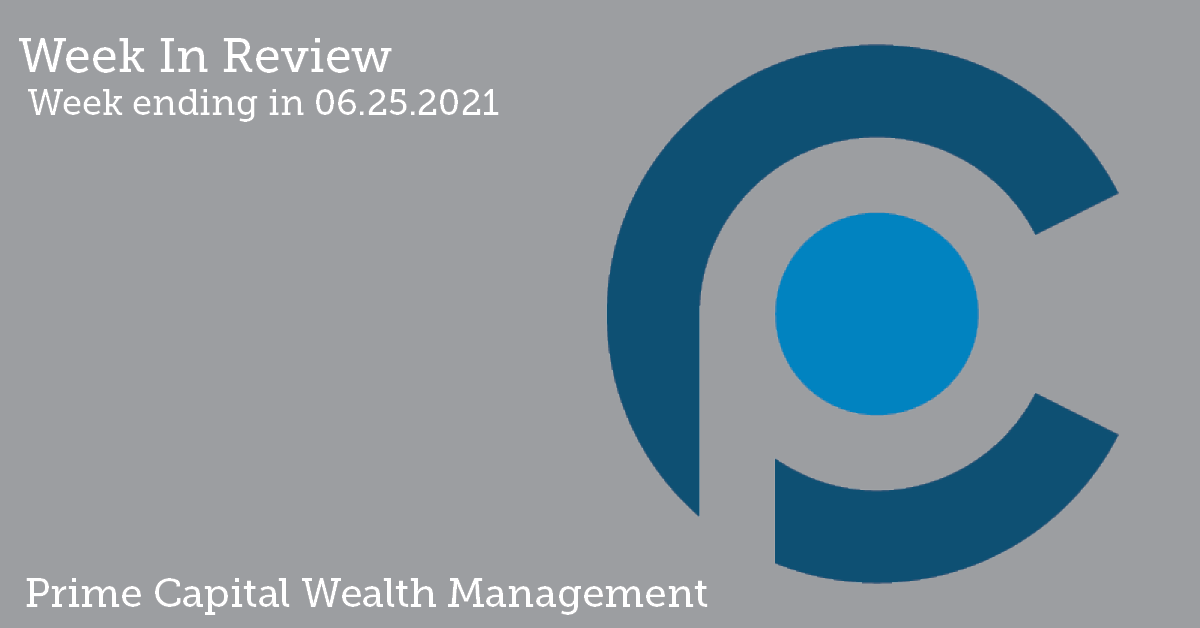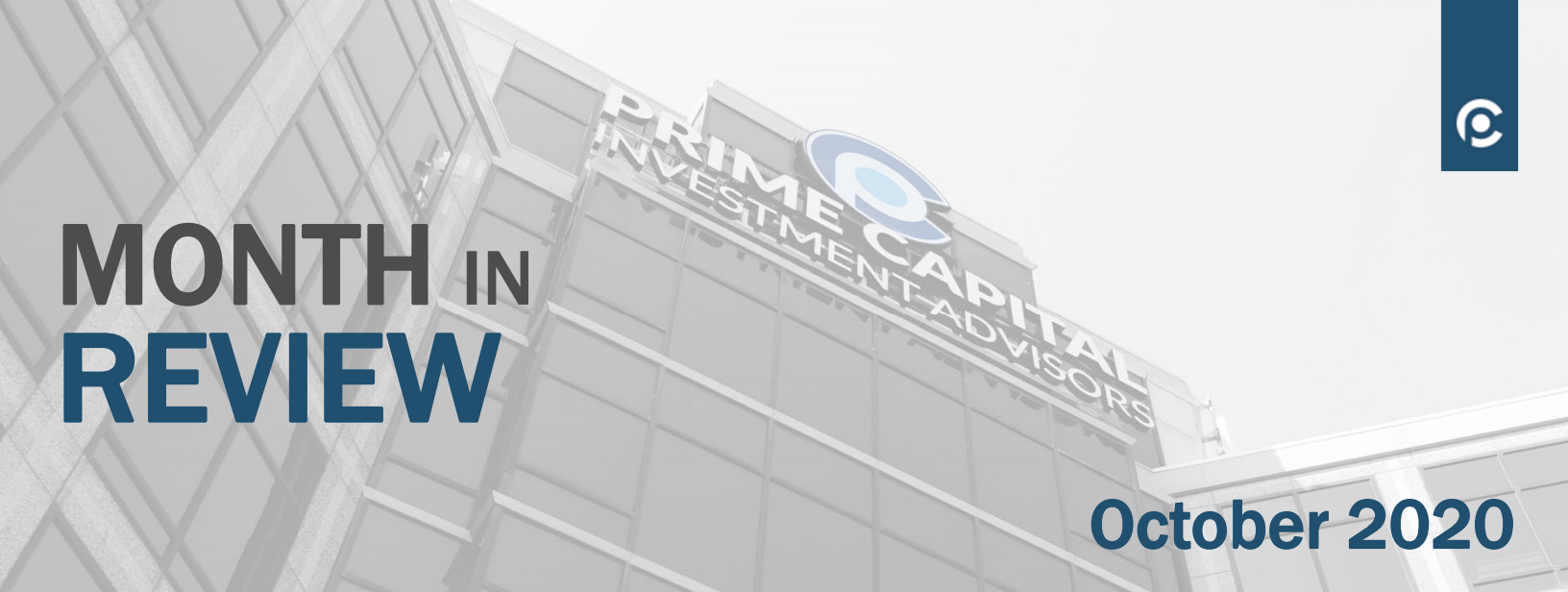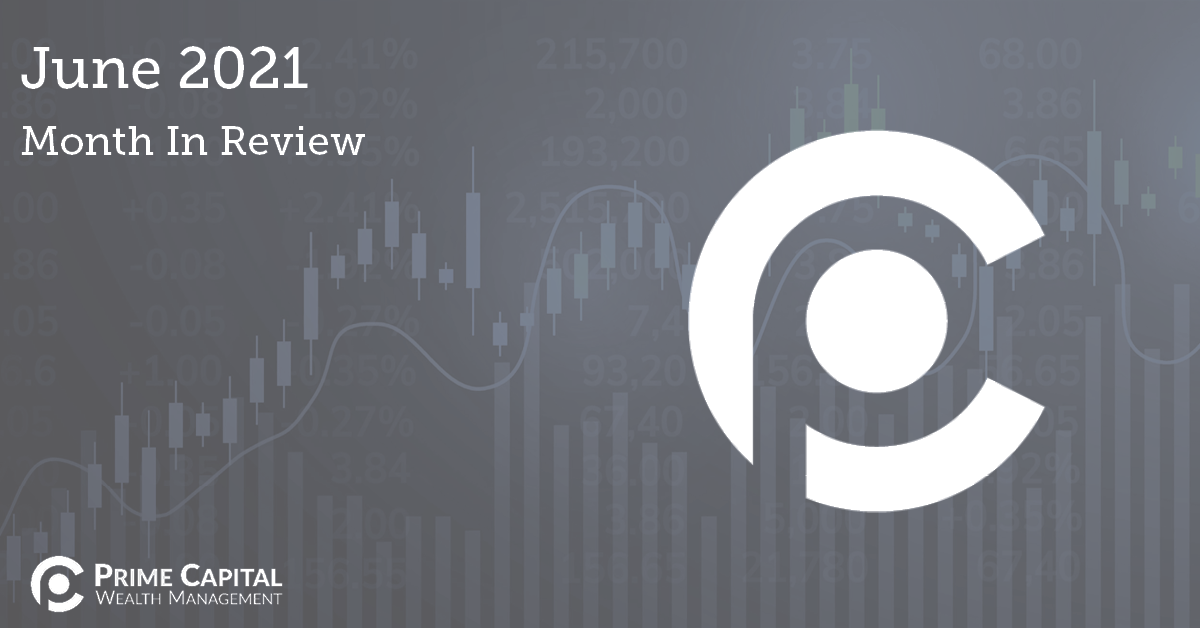The Bottom Line
● Trading remains choppy but volatility dropped as stocks rallied to new record highs and rebounded nicely from last week’s pullback. Gains were broad based with both U.S. and overseas stocks rising across styles and sectors.
● The yield on the 10‐year U.S. Treasury turned higher this week, following Fed Chair Powell’s dovish Capitol Hill testimony, in contrast to the Fed’s hawkish tone the prior week. As a result, the yield curve returned to steepening.
● Economic data continued to suggest solid expansion with stronger than expected growth in the preliminary June manufacturing and services purchase managers indices which hit a new record high of 62.6.
Stocks rebound from last week’s fall
Stocks posted solid weekly gains and set more fresh record highs along the way. The S&P 500 finished at an all‐time high on Friday, capping its best week since February with a +2.7%advance to rebound from last week’s Federal Reserve‐induced pullback. The giant cap Dow Jones Industrial Average rose +3.4%, the small cap Russell 2000 Index popped +4.3%, and the tech‐heavy Nasdaq Composite climbed +2.4%, after hitting an all‐time high on Thursday. As stocks rallied, Treasuries were choppy after last week’s hawkish monetary policy comments by the Fed, while Fed Chairman Jerome Powell was more dovish this week in his Congressional testimony stating the central bank sees no risk of runaway inflation and will support the economy for as long as it takes to complete its recovery. The yield on the 10‐year note rose +8 basis points (bps) over the week to 1.52%. The Treasury yield curve steepened after last week’s unexpected flattening. On Thursday a group of bipartisan Senators and President Biden agreed on a nearly $1 trillion spending package over five years for core infrastructure projects such as roads, bridges, and mass transit. Economic data continues to suggest solid expansion.
Digits & Did You Knows
STOCKS AND INFLATION — In the last 70 years (1951‐2020), inflation as measured by the Consumer Price Index (CPI) has been at least +5% in 12 different years, most recently in 1990. The total return for the S&P 500 has been split over those 12 high‐inflation years, rising in 6 and falling in 6. The average total return for the S&P 500 over all 12 years is just+3.2% (source: BTN Research).
FEWER CHOICES — There were 1.16 million existing homes for sale in the U.S. as of 4/30/21, up a bit from the 1.03 million for sale as of 2/28/21, which was the lowest level ever reported for data tracked since 1999 (source: National Association of Realtors, BTN Research).

Click here to see the full review.
—
Source: Bloomberg. Asset‐class performance is presented by using market returns from an exchange‐traded fund (ETF) proxy that best represents its respective broad asset class. Returns shown are net of fund fees for and do not necessarily represent performance of specific mutual funds and/or exchange‐traded funds recommended by the Prime Capital Investment Advisors. The performance of those funds may be substantially different than the performance of the broad asset classes and to proxy ETFs represented here. U.S. Bonds (iShares Core U.S. Aggregate Bond ETF); High‐YieldBond(iShares iBoxx $ High Yield Corporate Bond ETF); Intl Bonds (SPDR® Bloomberg Barclays International Corporate Bond ETF); Large Growth (iShares Russell 1000 Growth ETF); Large Value (iShares Russell 1000 ValueETF);MidGrowth(iSharesRussell Mid‐CapGrowthETF);MidValue (iSharesRussell Mid‐Cap Value ETF); Small Growth (iShares Russell 2000 Growth ETF); Small Value (iShares Russell 2000 Value ETF); Intl Equity (iShares MSCI EAFE ETF); Emg Markets (iShares MSCI Emerging Markets ETF); and Real Estate (iShares U.S. Real Estate ETF). The return displayed as “Allocation” is a weighted average of the ETF proxies shown as represented by: 30% U.S. Bonds, 5% International Bonds, 5% High Yield Bonds, 10% Large Growth, 10% Large Value, 4% Mid Growth, 4%Mid Value, 2% Small Growth, 2% Small Value, 18% International Stock, 7% Emerging Markets, 3% Real Estate.
Advisory services offered through Prime Capital Investment Advisors, LLC. (“PCIA”), a Registered Investment Adviser. PCIA doing business as Prime Capital Wealth Management (“PCWM”) and Qualified Plan Advisors (“QPA”).
© 2021 Prime Capital Investment Advisors, 6201 College Blvd., 7th Floor, Overland Park, KS 66211.





 that jumped +26.6%. Gains like those, even off the extraordinarily low bases from the depths of last year’s COVID lockdowns, are bound to create inflation concerns. U.S. stocks pulled back more than ‐4% from the May 7th all‐time highs in both the second and third weeks of the month, and VIX volatility spiked to about 28 and 26 on each of those declines. But in the end the bulls took the victory as investors pushed aside the inflation fears in favor of recovery optimism. The S&P 500 rose +0.7% to post its fourth consecutive positive month, and sixth of the past seven. The small‐cap Russell 2000 index, which is more leveraged to the economic reopening, posted its eighth straight positive month for the first time since 1995.
that jumped +26.6%. Gains like those, even off the extraordinarily low bases from the depths of last year’s COVID lockdowns, are bound to create inflation concerns. U.S. stocks pulled back more than ‐4% from the May 7th all‐time highs in both the second and third weeks of the month, and VIX volatility spiked to about 28 and 26 on each of those declines. But in the end the bulls took the victory as investors pushed aside the inflation fears in favor of recovery optimism. The S&P 500 rose +0.7% to post its fourth consecutive positive month, and sixth of the past seven. The small‐cap Russell 2000 index, which is more leveraged to the economic reopening, posted its eighth straight positive month for the first time since 1995. Importantly, vaccination rates in Europe have picked up after a relatively slow start. That has helped Eurozone economic sentiment improve for four straight months and hit its highest level since 2018.The COVID crisis in India has also made much needed progress with over 190 million vaccines so far administered–only behind the totals of US and China. As a result, those economies are also rebounding nicely. As seen in the chart above, both developed and emerging international PMIs are rising and are well into expansion levels (above 50). The MSCI EAFE Index gained +3.3% in May, outperforming U.S. stocks for the first time in 2021.
Importantly, vaccination rates in Europe have picked up after a relatively slow start. That has helped Eurozone economic sentiment improve for four straight months and hit its highest level since 2018.The COVID crisis in India has also made much needed progress with over 190 million vaccines so far administered–only behind the totals of US and China. As a result, those economies are also rebounding nicely. As seen in the chart above, both developed and emerging international PMIs are rising and are well into expansion levels (above 50). The MSCI EAFE Index gained +3.3% in May, outperforming U.S. stocks for the first time in 2021.










 round of stimulus checks in mid-March, accelerated reopening, and accumulated savings, should boost spending for March and beyond. Given that the consumer accounts for roughly 70% of our economy’s output, spending is a significant driver for economic growth. The composite Purchasing Managers Index (PMI) has
round of stimulus checks in mid-March, accelerated reopening, and accumulated savings, should boost spending for March and beyond. Given that the consumer accounts for roughly 70% of our economy’s output, spending is a significant driver for economic growth. The composite Purchasing Managers Index (PMI) has accelerated recently, well beyond pre-COVID
accelerated recently, well beyond pre-COVID Since the Fed is targeting an average inflation level of 2%, these reports are critical to monitor and decipher, which may prove more difficult when accounting for the recent $1.9 trillion pandemic relief package. Given significant monetary and fiscal stimulus provided over the last year and supply chain disruptions resulting from the pandemic, it is hard to envision an outcome where inflation does not rise. Some would suggest that we are positioned for hyperinflation. In contrast, others like the Fed and Treasury Secretary, Janet Yellen, believe we will experience higher inflation levels, though the elevated levels will prove transitory and will ultimately normalize. They have been vocal about their expectations and the impact of the base effect over the coming months. While they have communicated their expectations surrounding the illusory readings expected, we would not be surprised if some investors still view elevated readings as confirmation that inflation is surging, which could lead to market volatility in both equities and bonds.
Since the Fed is targeting an average inflation level of 2%, these reports are critical to monitor and decipher, which may prove more difficult when accounting for the recent $1.9 trillion pandemic relief package. Given significant monetary and fiscal stimulus provided over the last year and supply chain disruptions resulting from the pandemic, it is hard to envision an outcome where inflation does not rise. Some would suggest that we are positioned for hyperinflation. In contrast, others like the Fed and Treasury Secretary, Janet Yellen, believe we will experience higher inflation levels, though the elevated levels will prove transitory and will ultimately normalize. They have been vocal about their expectations and the impact of the base effect over the coming months. While they have communicated their expectations surrounding the illusory readings expected, we would not be surprised if some investors still view elevated readings as confirmation that inflation is surging, which could lead to market volatility in both equities and bonds.


 Meet Wyatt Schrepfer! Wyatt is a financial advisor in our Boerne, TX office, and he specializes in individual wealth management tailored to your specific and unique objectives, as well as company retirement plan services. Wyatt joined PCIA because of his love for helping and serving others. He believes wealth management is a great way to continue to help others.
Meet Wyatt Schrepfer! Wyatt is a financial advisor in our Boerne, TX office, and he specializes in individual wealth management tailored to your specific and unique objectives, as well as company retirement plan services. Wyatt joined PCIA because of his love for helping and serving others. He believes wealth management is a great way to continue to help others.